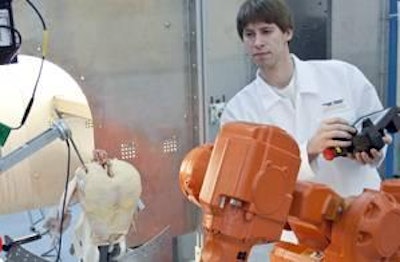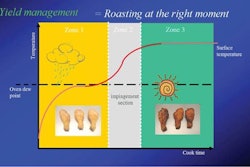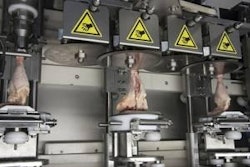
Deboning operations are one of the most labor intensive activities in today’s poultry plants. Efforts have been made over the years to automate this function, but to date these systems have achieved only limited success. The main difficulty associated with this task is the lack of precisely defined structures due to the natural variability in the sizes of birds and their deformable bodies. To increase product quality/safety and reduce worker exposure to highly repetitive and potentially injury-prone tasks, the industry is looking to robotics as a potential solution.
As part of an effort to fully understand the need for automation and the requirements for the cutting system, researchers at the Georgia Tech Research Institute (GTRI) have been conducting a multi-year study on the ergonomics and risk of musculoskeletal injury associated with the shoulder deboning operation. Until a robotic or automated solution can be devised, poultry processors need a tool to assess the risk of injury associated with the existing manual tasks. To this end, GTRI researchers in conjunction with member companies of the Georgia Poultry Federation have put together a program to develop an instrument to assess the risk of musculoskeletal injury associated with the deboning process and the musculoskeletal effects on the upper and lower arm. The specific ergonomic factors related to these cutting tasks include grip force, posture, and repetition.
Ergonomic Worker Assessment System
While the industry has made great strides in designing ergonomic workstations to address some of the contributing factors, there are still questions about how much muscle fatigue actually occurs with the various tasks. The ultimate goals for this research program include being able to better assist plants and ergonomists in developing effective worker rotation schemes and training programs for new and inexperienced workers to minimize the risk of injury.
To accomplish these goals, an Ergonomic Worker Assessment System (EWAS) has been developed to measure the muscle stress/strain of the fore- and upper-arm, and the position/posture of the shoulder, back, arm and wrist. Leveraging computer gaming technology to track human movement, a Measurand ShapeTape fiber optic position measurement system has been integrated with EMG sensors and a Liberty Mutual Research Institute for Safety instrumented grip force measurement tool. The system is used to wirelessly collect data from workers on an actual processing line in the plant.
Best ‘wing cut’ technique
Testing of the system on an actual processing line included both experienced and inexperienced workers as well as fresh and fatigued workers. An initial analysis of the data resulted in several interesting observations associated with the wing cut, as shown in Figure 1.
- Experienced workers exhibit a larger yaw motion of the back in the coronal plane when compared to inexperienced workers.
- Experienced workers exhibit a much smoother cut trajectory in the z-plane when compared to inexperienced workers.
- Experienced workers exhibit less rotation or twist of the upper body in the transverse plane when compared to inexperienced workers.
- When experienced workers become fatigued, their work patterns trend towards those of the inexperienced workers.
Better training and rotation schemes
While these are only preliminary results, they already provide insight into some of the differences between experienced and inexperienced workers and fatigued and fresh workers. With this new information, ergonomists can now design better training programs and rotation schemes to minimize the risk of injury to inexperienced workers and reduce the overall level of muscle fatigue. Improved postures and reduced muscle fatigue can also reap benefits beyond worker safety as it is sure to have an impact on overall yield performance as well.
Automation hurdles in yield, bone chips
In addition to reducing worker exposure to these difficult tasks, automation seeks to increase the yield of breast meat and reduce/eliminate bone chips. It is estimated that an increase in yield of a single percentage point could represent several millions of dollars of additional revenue for each plant.
Current attempts at automating the shoulder cut impose several percentage points of yield loss in return for lower labor costs. In the manual process, while generally providing a higher yield of breast meat, the quality of the product varies dramatically based on the skill of the worker. It is the goal of the intelligent deboning research to develop a system that eliminates labor and consistently provides a yield similar to the best manual worker while eliminating bone chips.
The prototype GTRI system uses a vision system to predict the position of the shoulder tendons. The position data is communicated to the robot controller that moves the knife directly above the predicted location of the shoulder tendon. Upon entering the cutting cell, the controller begins to move the blade down into the shoulder. The blade follows a predefined trajectory that is customized for each bird based on the vision data.
Once the blade enters the meat, the controller begins to look for the bone as it follows the predefined trajectory. When initial contact with the bone is detected, the controller switches to a force control algorithm to guide the blade along the bone to cut the tendons without cutting into the bone. This prevents the creation of any bone fragments.
Once the blade has completed the cut around the bone, the system switches to a different control algorithm that guides the blade along the scapula bone; again, without generating any bone chips.
Imaging software helps identify cut points
GTRI has developed a novel approach to the prediction of the location of the bones and tendons within the shoulder joint. The concept utilizes imaging software to identify three key points on the bird. From these locations, a software algorithm predicts the location of the tendons and thus the initial cutting point for the shoulder cut. This method is accurate to approximately ±3 mm. This is sufficient for the robot to begin the cut. The advantage of this approach is that it addresses many of the factors that account for the variability of the tendons and joint in the bird. This includes natural variations in the bird anatomy, the deformation of the bird, and the unpredictable placement of the bird on the cone.
The influence of the blade edge shape and its slicing angle on the cutting of biomaterials has also been studied. Through modeling of the cutting force, an optimal slicing angle can be formulated based on the production rate while minimizing the cutting forces.
One of the key research questions is: how does one detect a bone without cutting into it? This problem must be addressed if the system is going to meet one of its key design goals: the elimination of bone chips.
It is relatively easy for a computer to detect when the blade is cutting into a bone – simply look for a force spike on the blade. However, by the time the force has spiked, the blade has already cut deep in to the bone and a bone chip is almost guaranteed. The research task is to detect the bone prior to cutting into it. While the work is still preliminary, initial tests have identified a unique force signature that when combined with knowledge of the anatomy of the bird (obtained by the imaging system), allow the computer to identify the bone and withdraw the blade from the bird. Initial tests have shown that the system is able to detect the bone and withdraw from the meat while cutting less than 1 mm. into the bone.
Initial system testing in early 2010
The research team is currently implementing a force control algorithm that will guide the blade around the bone. The algorithm has been tested in simulation, but extensive testing of the system is still required. The initial testing of the system will be conducted in early 2010.
GTRI has been working for several years to address a critical need for the poultry industry: automating the shoulder cut while maximizing yield without generating bone chips or fragments. Researchers at GTRI are also studying the ergonomics and risk of musculoskeletal injury associated with this cut. This works highlights the need for automation in this area. The team has constructed the first integrated work cell capable of testing and evaluating the ideas developed at GTRI. While the work is still two years away from its first real field testing, the preliminary results are promising and the team is looking forward to testing its concepts in the field.

















